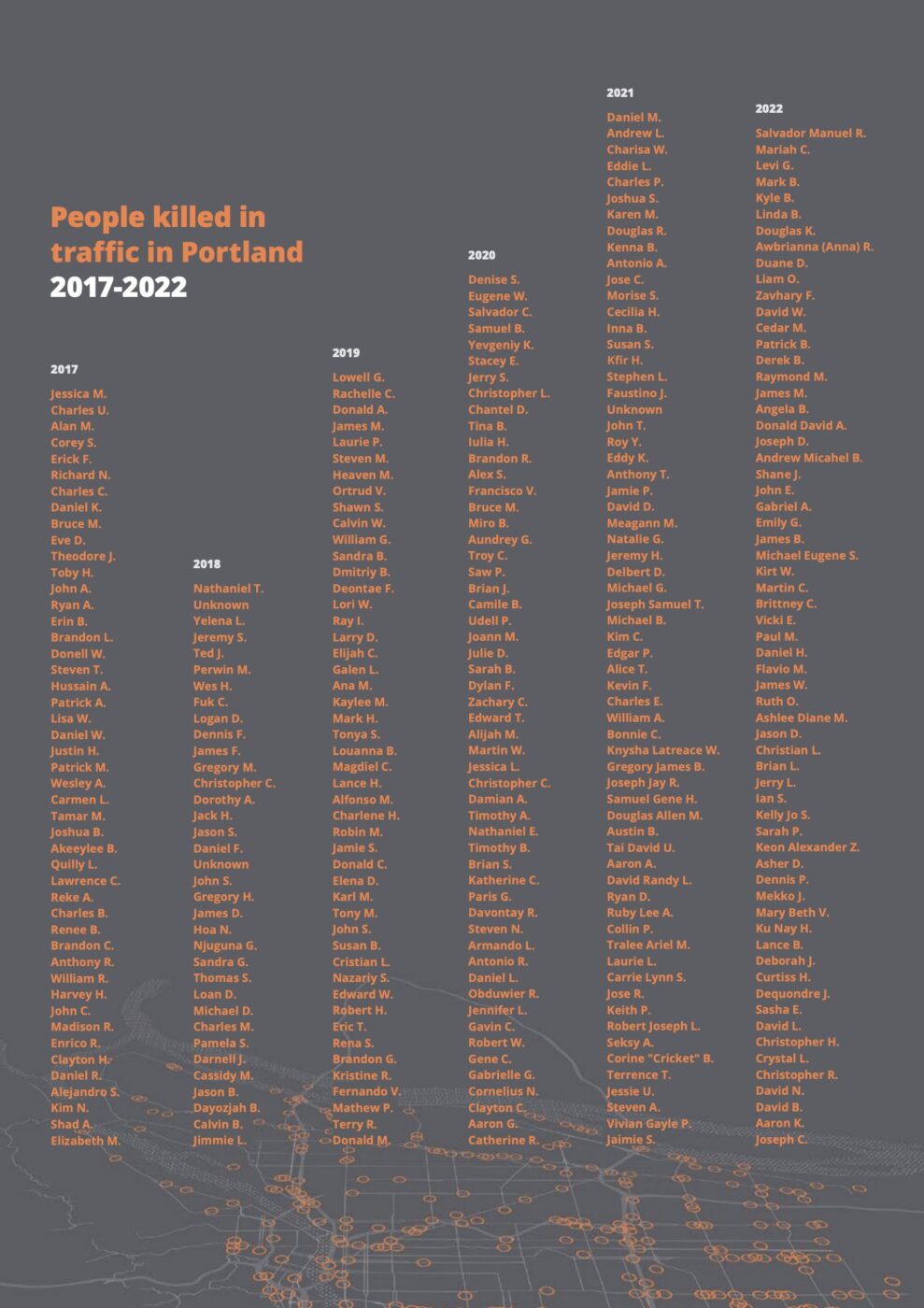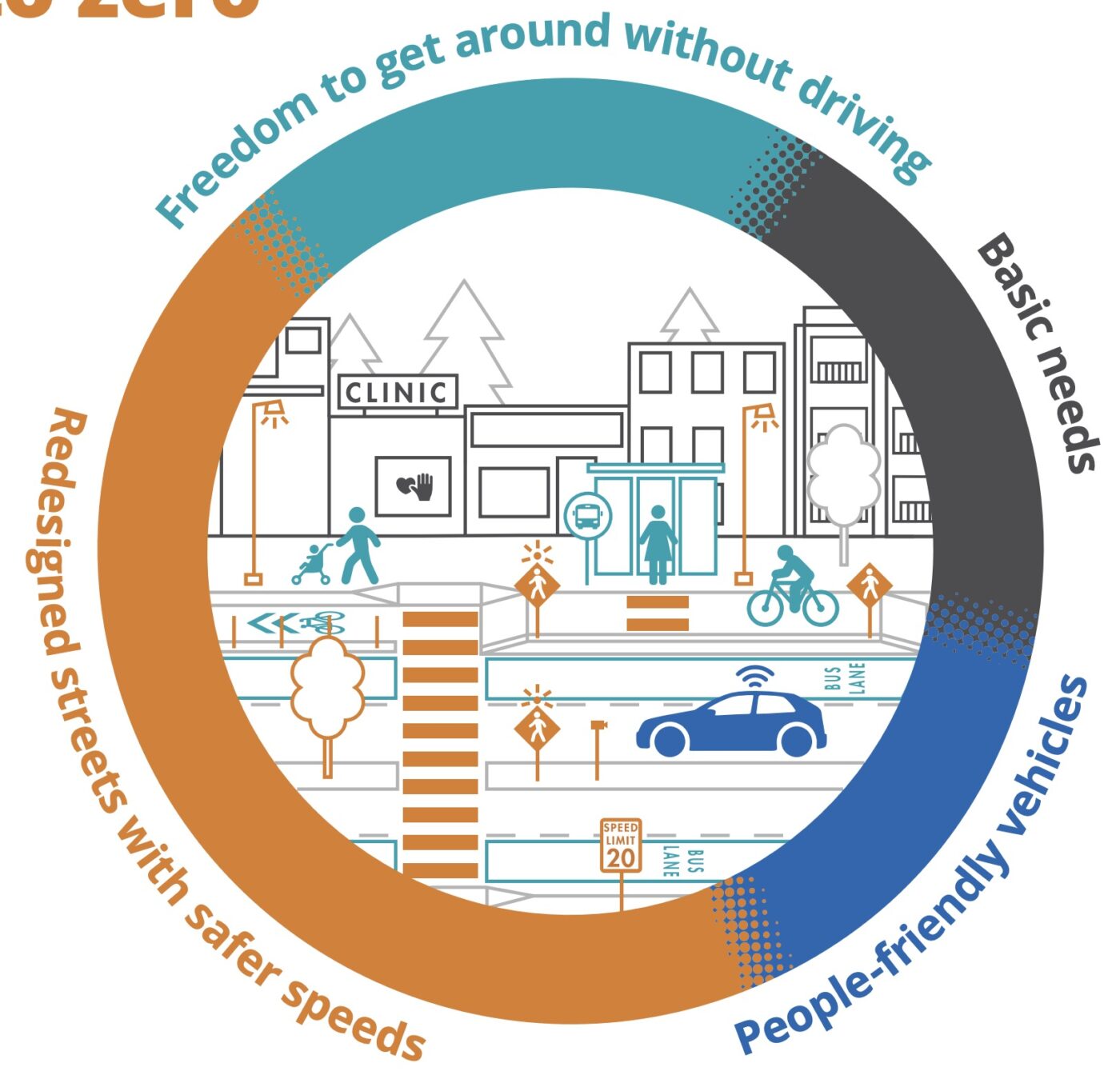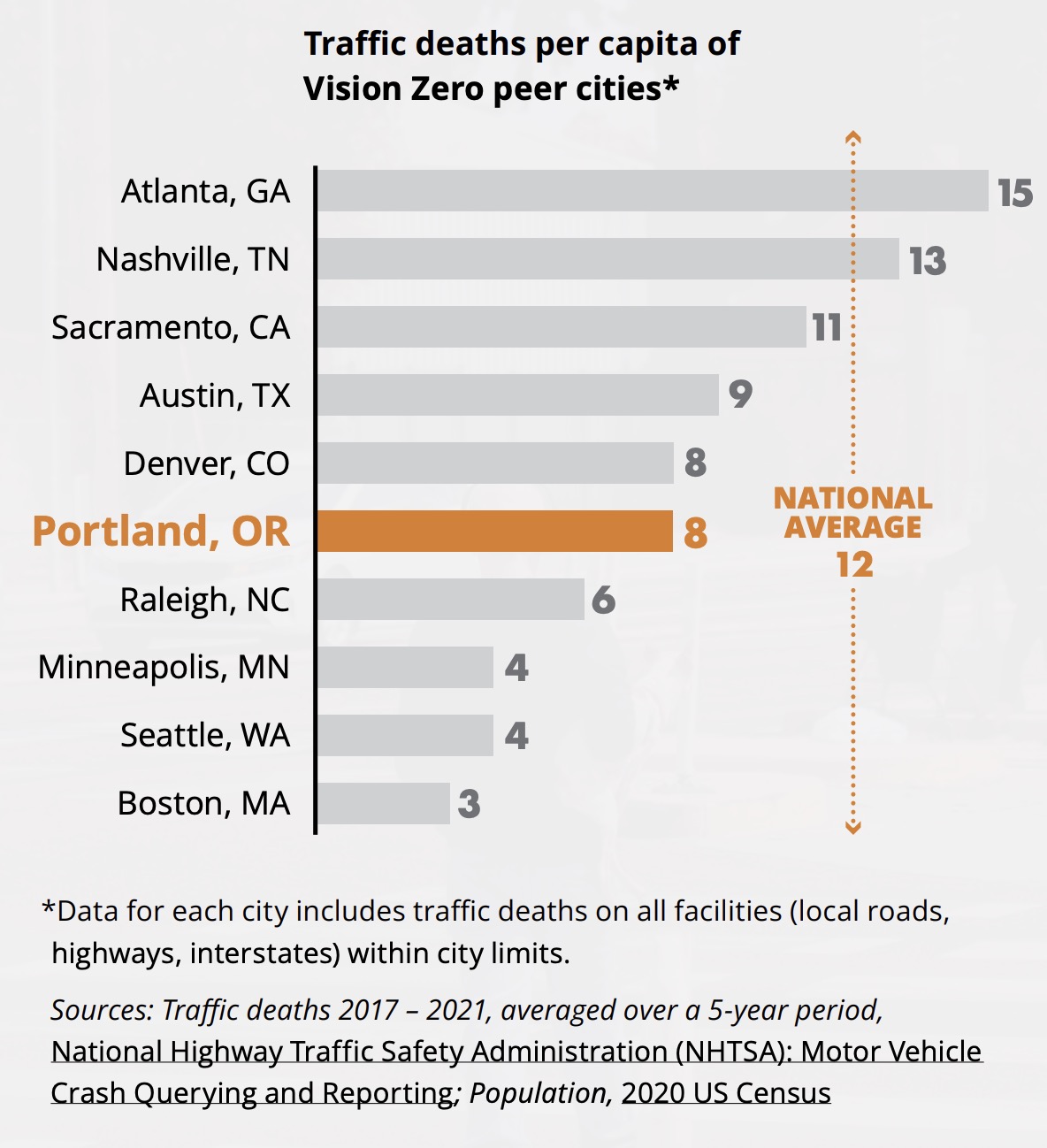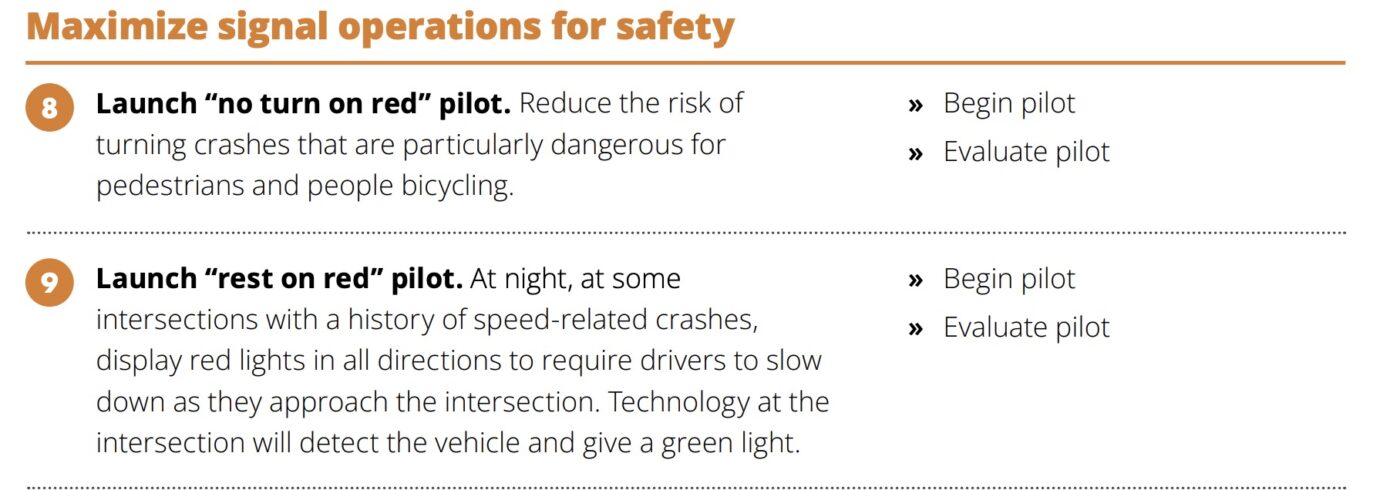 PBOT says they’ll make a list of locations where plastic will be replaced with concrete. (Photo: Jonathan Maus/BikePortland)
PBOT says they’ll make a list of locations where plastic will be replaced with concrete. (Photo: Jonathan Maus/BikePortland)
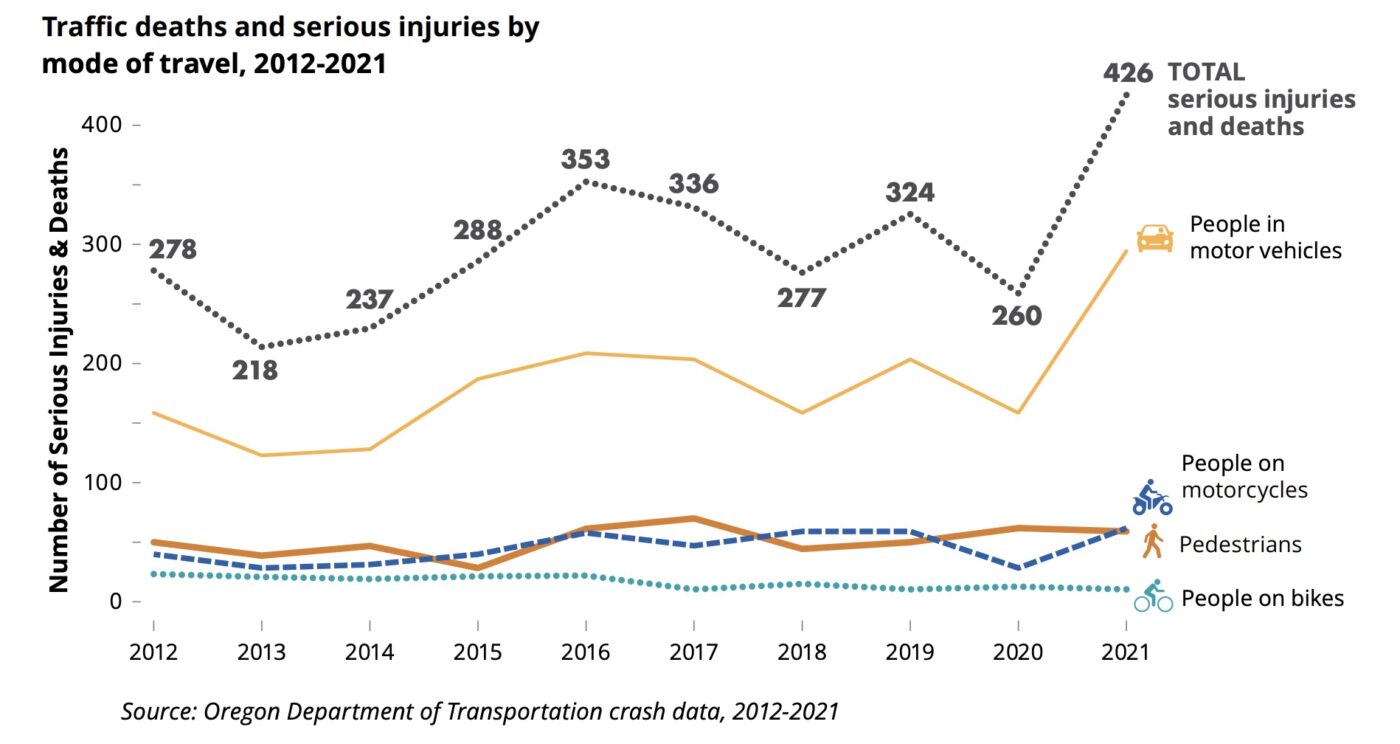 (Source: PBOT Vision Zero Action Plan Update 2023-2025)
(Source: PBOT Vision Zero Action Plan Update 2023-2025)
A person was killed while walking on SE McLoughlin Blvd (Highway 99E) early this morning. It’s the fifth death on the State-owned highway since early 2021 and three of those were pedestrians.
According to our Fatality Tracker, this was the 61st death of 2023 — that’s three more than we had last year and puts us on the same pace as 2021 which was our highest toll since 1990.
Portland first passed its Vision Zero Action Plan in 2016 with a goal to the goal to eliminate traffic deaths and serious injuries on Portland streets by 2025. It’s now crunch-time for that effort. Despite efforts from the Portland Bureau of Transportation and its partners, 372 people have been killed in traffic crashes since 2017 and the numbers are going in the wrong direction.
That’s the sad but true context for the publication of an update to PBOT’s Vision Zero Action Plan released earlier this month. Among the list of actions PBOT says they’ll embark on in the next two years is to pilot new “no turn on red” and “rest on red” traffic signal projects and rekindle their enforcement relationship with the Portland Police Bureau. Here’s what else you need to know about this report…
This is the first update on Vision Zero PBOT has published since 2019 and the 48-page report is meant to guide their work through the 2025 target date. The new action plan provides a helpful snapshot of where things stand and gives advocates a helpful resource to hold the City of Portland accountable.
The report opens with a somber listing of names of everyone who has died in traffic crashes between 2017 and 2022 (above). The 311 names in small font, stack high like skyscrapers above a map of dots that marks where they died. And these are just the dead. The list doesn’t include names of people with seriously, life-changing injuries or the hundreds of family members and friends whose lives will be forever incomplete.
And while the numbers are outrageous and unacceptable, it’s important to remember that PBOT is just one of several government agencies in our city who are responsible for street safety. Metro, Multnomah County, the Portland Police Bureau, and of course the Oregon Department of Transportation, all play major roles. For instance, one of the four main focus areas for “getting to zero” is a new emphasis on “basic needs,” which they’ll lean on partners in housing, job access, drug abuse and mental health services to address.
For their part, PBOT points to some success in the report. They say a pilot program to install left-turn calming bumps at 42 intersections citywide has led to a 13% reduction in turning speeds. The number bike riders hurt or killed on our roads has also trended solidly downward in the past decade. And perhaps PBOT’s best success story comes from their years-long war on speeding. Thanks to a combination of automated enforcement cameras, street design, marketing, and other efforts, the report says speeding has dropped 71% along high crash corridors and top-end speeding (i.e., people driving 10 mph or more over the speed limit) has dropped 94%.
PBOT also wants the public to know that Portland is not alone in this struggle for safer roads. The report points out that in the last five years there’s been a 17% increase in traffic deaths across the U.S. “Compared to Vision Zero peer
cities in the U.S. with similar population, Portland’s traffic death rate is in the middle,” the report states, next to a chart showing Portland’s rate at 8 deaths per 100,000 residents compared to the national average of 12.
Here are a few more notable stats from the report:
Pedestrians face the greatest risk in Portland’s transportation network. Roughly 5.7% of Portlanders primarily walk to work, yet 40% of all traffic-related deaths from 2018-2022 were pedestrians. Housing status data from 2021 and 2022 police crash reports indicate that 55% of pedestrians killed—30 out of 55—were unhoused when they died. Impairment and speed are the two largest contributing factors to fatal traffic crashes, playing a major role in 69% and 42% of all deaths respectively. Recent Portland data shows that Black and Indigenous community members died in traffic crashes at about twice the rate relative to their proportion of the population. 70% of pedestrian deaths and serious injuries occurred at night (2017-2021). Wide streets, which make up 4.5% of Portland streets, accounted for nearly half of all deadly crashes in Portland from 2017-2021 and more than half of pedestrian deaths and serious injury crashes (52%). Hit-and-run crashes were up 27% in the last fve years (2017-2021) compared to the fve years prior. Hit-and-run crashes represent one in seven deaths or serious injuries of pedestrians and people biking.The section on “actions and performance measures” shared a few new things that caught my eye.
PBOT plans to launch a “no turn on red” pilot (above) to reduce risk of turning crashes, “that are particularly dangerous for pedestrians and people bicycling.” This follows growing national attention on the risks of turning on red signals and how that policy is woefully outdated. PBOT has already implemented it at several intersections, but this appears to be an expansion of the policy. Another traffic signal pilot PBOT wants to launch is called, “rest on red.” Here’s how PBOT describes it:
“At night, at some intersections with a history of speed-related crashes, display red lights in all directions to require drivers to slow down as they approach the intersection. Technology at the intersection will detect the vehicle and give a green light.”
The report also addresses a growing push for more physical protection of bike lanes with a promise to develop a list of locations and find funding to “upgrade temporary materials (such as rubber curbs and flexible posts) to permanent materials (such as concrete).”
And it looks like a partnership with the PPB that iced over during the racial justice protests in the summer of 2020 is beginning to thaw. PBOT says they will partner with the (newly bolstered) Traffic Division on “focused enforcement” and to, “ensure training for new police recruits includes data about traffic safety, how to process DUII offenses, and city and state protocol and laws around making traffic stops.”
The narrative that a “massive investment” is needed to stem the tide of deaths is woven throughout the report. As we’ve reported, PBOT is facing its most daunting budget in history and is contemplating vast cuts to staff and programs unless new revenue can be found.
Regardless of the budget situation, the clock is ticking loudly on the City of Portland and their partners when it comes to the woeful trend of tragedies on our streets. We have two years left to make the bold moves necessary to reach our Vision Zero goal.
— Read the Vision Zero Action Plan Update 2023-2025 here. You may also be interested in the annual World Day of Remembrance event (hosted by The Street Trust) on Sunday, November 19th, that will consist of a walk and vigil.

